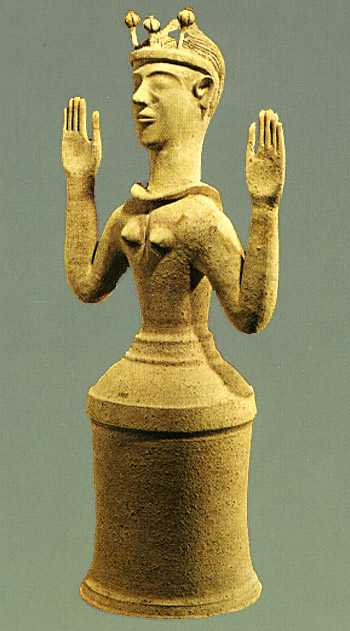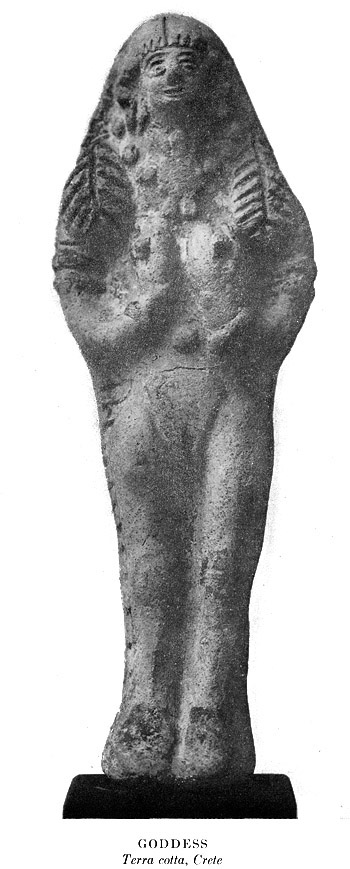 This goddess or priestess figure is from ancient Crete. The Minoan civilization which produced it has such a wealth of goddess imagery I hardly know where to begin, but this one comes to me in meditation. She was made from clay about 2300 years ago.
This goddess or priestess figure is from ancient Crete. The Minoan civilization which produced it has such a wealth of goddess imagery I hardly know where to begin, but this one comes to me in meditation. She was made from clay about 2300 years ago.
She holds her hands up to receive and bestow wisdom. Her tubular skirt is typical of many of these figurines and can be seen as an opening for earth wisdom to rise up into her. Her eyes seem closed, as if in trance. And from her crown arise three poppy seed pods.
Poppies are the source of opium, which has been used for millennia not only for sacred trance, but for its unequaled pain relief. Many if not most of today’s narcotic pain relief originates in the poppy. It is also the source of heroin. The poppy, like many medicinal plants, has its dark and light sides. This figure’s crown shows her to be an initiate of poppy’s mysteries.
 The goddess on the left wears a bird crown; the poppy goddess on the right is an elder and her arms are more tired.
The goddess on the left wears a bird crown; the poppy goddess on the right is an elder and her arms are more tired.
Body wisdom: This posture appears in qigong exercises and is also a posture I have seen many people use while praying, both pagan and christian. I meditate on poppy’s gifts: during mortal illness or wounds, end of life, major surgeries, chronic pain, poppy makes these difficult things more bearable. A gift from the plant kingdom indeed.
Top image from a now broken link; apologies. But this might be a resource: http://www.hartzler.org
Bottom image: The Great Mother, Erich Neumann




Beautiful.
I was wondering the same things. I will refer to this post, as it is admirably stated.
I am working on a book about my career as an artists and I have an image of the Minoan Goddess with Bird crown on the left above. I took the photo at the Heraklion Museum I think, but I am wondering your source for the image? I need to get permission to use it I believe, but Heraklion Museum does not respond. (It’s my own photograph from 1978) If you have any information that might help me I’d certainly appreciate it.
Thanks so much. Jane Gilmor
Jane, if you are using your own picture you have no need to ask anyone to use it except yourself. If you want to use this particular image, you can try contacting the photographer and asking him. If you glean out the website at the beginning of the live link at the bottom of my post, it was take you to http://www.hartzler.org/ with cc307 a subdivision of this home page. This is presumably an academic collection, a very nice collection of images, but he himself may have gotten it from the Hereaklion museum with academic credentials, or at least that is how it used to happen with the acquisition of slides of particularly historical art for universities.
Cari, Thanks so much! Actually Bruce Hartzler’s web site has a much nicer image of the same piece but I can not for the life of me find any way to contact him on his various web sites –no e-mail/ “contact”.
Am I blind? Do you have an e-mail contact? I’d like to get permission to use the image.
Thanks again!! Jane G
I have seen a very familiar or coincidental similarity with two ceramic figures displayed in Museo de Antropología de Xalapa. México… for which I suggest the two-handed gesture #1 seems to mimic the Egyptian hieroglyphic “in praise of Ra”, and #2 could also be related to the Cretan relationship with the poppy goddess. Interestingly, the head-dress has two different ??? plant-type symbols in the crown, which I cannot identify. The eyes do appear to be slightly closed, as if in a trance, as you suggest. Amazing.
Forgot to mention the website of the two ceramics… photo by Ritter Walder on Flickr.com